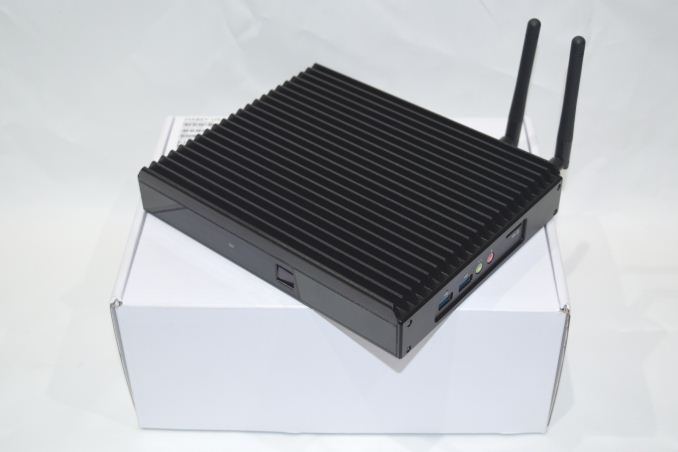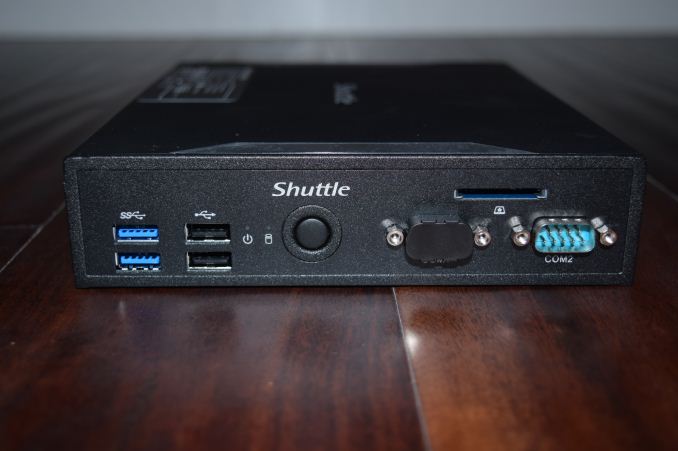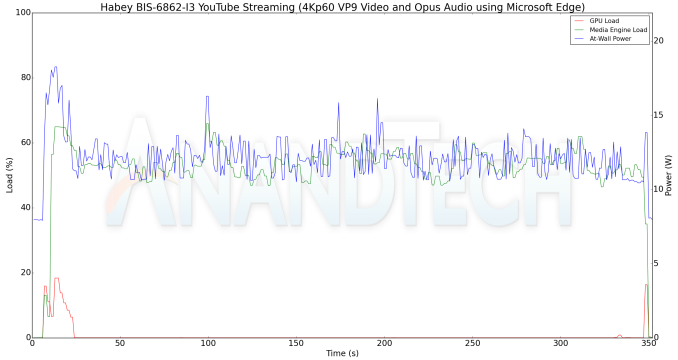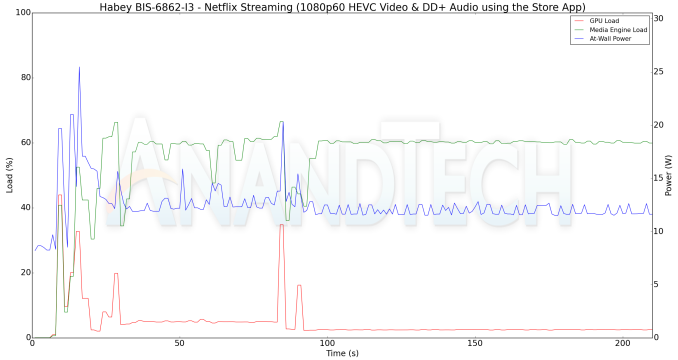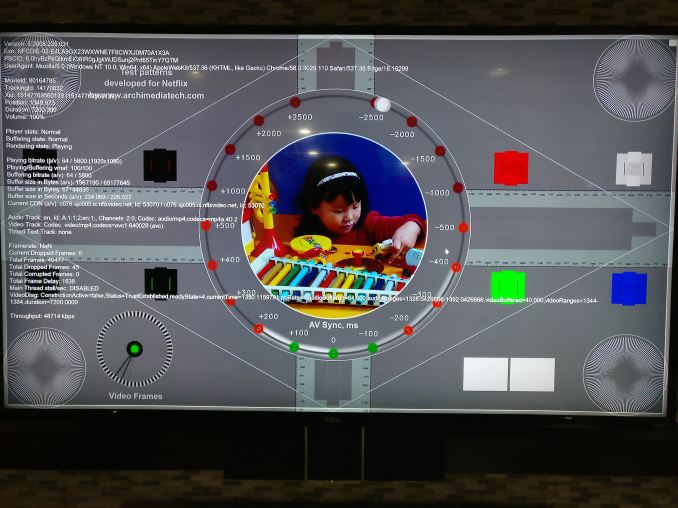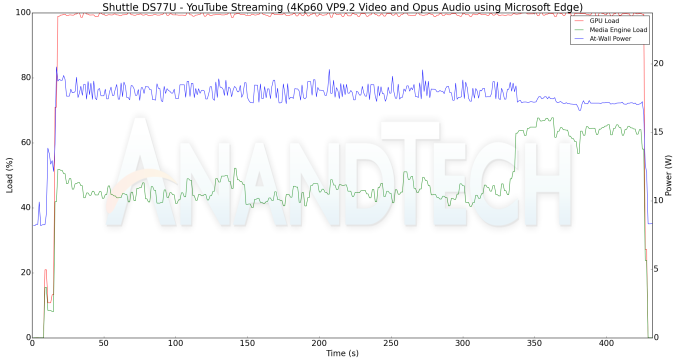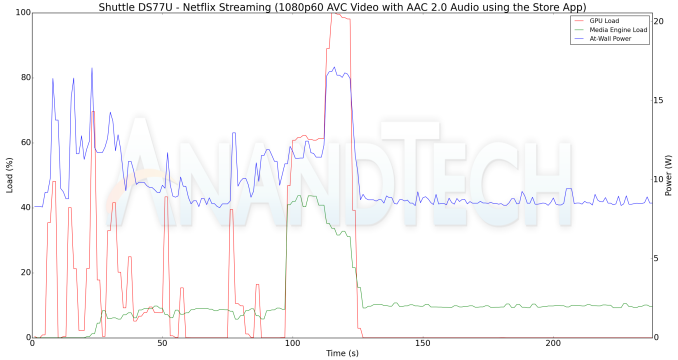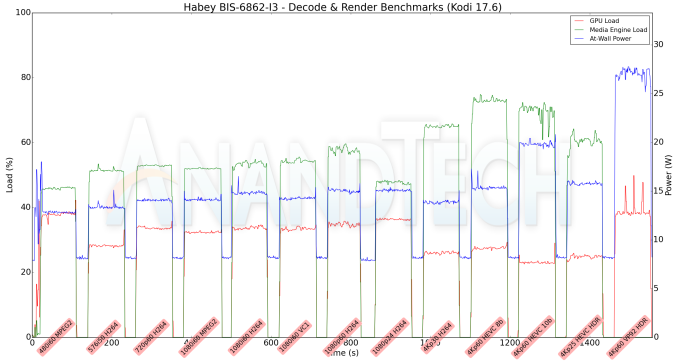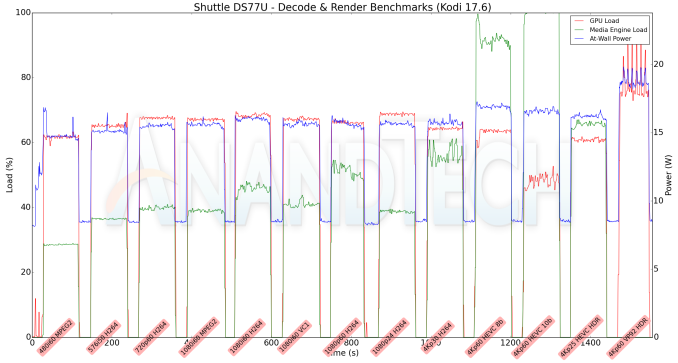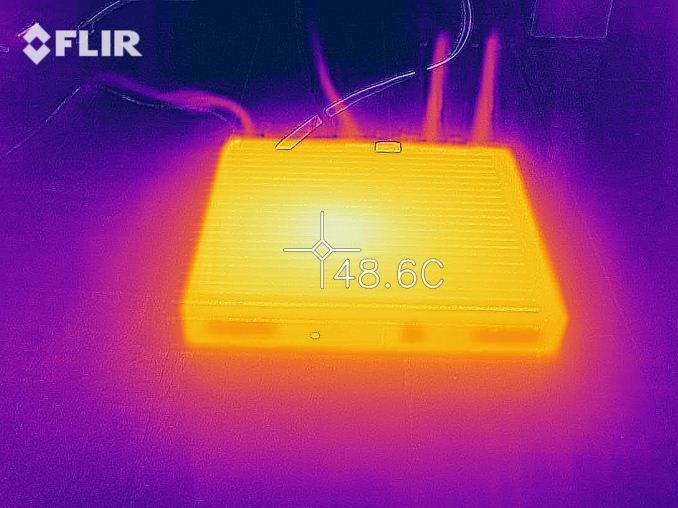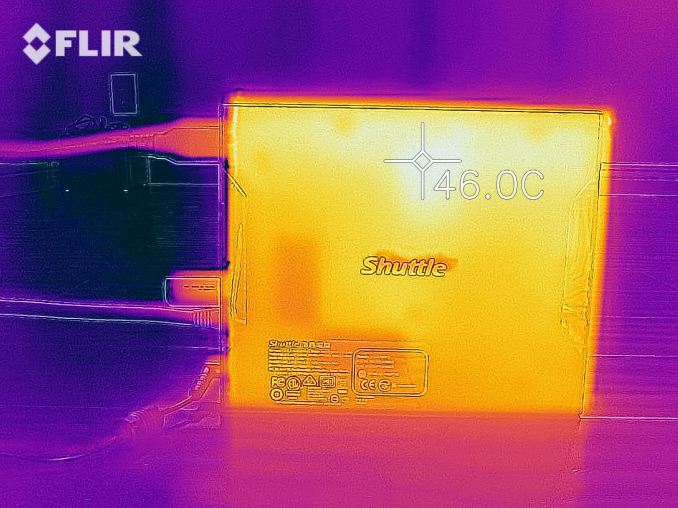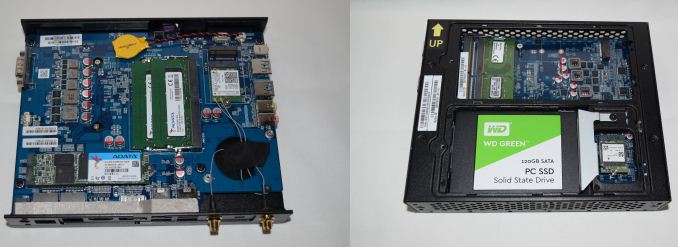
Original Link: https://www.anandtech.com/show/12206/shuttle-xpc-slim-ds77u-habey-bis6862-fanless-kaby-lake-industrial-pcs-review
Habey BIS-6862 & Shuttle XPC Slim DS77U Fanless Kaby Lake Industrial PCs Review
by Ganesh T S on January 5, 2018 8:00 AM EST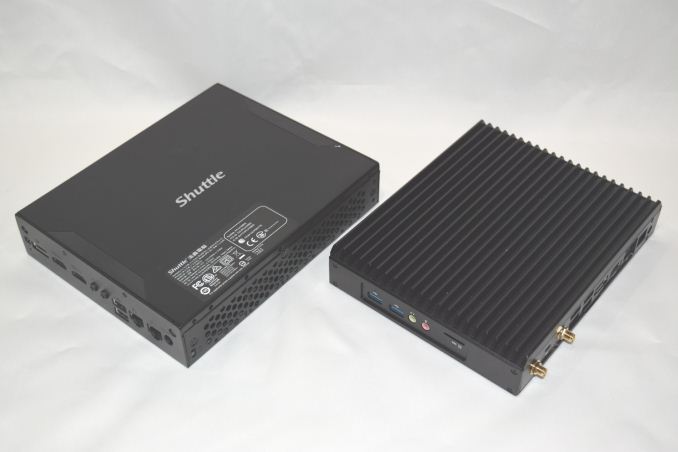
Passively cooled computing systems are popular amongst consumers worried about the reliability of moving parts, noise from fans, and other associated maintenance requirements (particularly, for industrial use-cases). Traditionally, fanless high-performance PCs have come with a high price tag. However, with the focus on low-power U-series CPUs by Intel, we have many vendors targeting this market segment with affordable models. Habey and Shuttle have both had a history of delivering high-performance fanless industrial PCs. Today, we look at two Kaby Lake-U systems - the Habey BIS-6862-I3 and the Shuttle DS77U.
Introduction
Industrial PCs come with stringent requirements that are not satisfied by generic PCs. It is customary for builders to use active cooling in order to ensure that the components are in proper working order. Ventilation slots are also provided to keep airflow up. Chassis size is also not always a concern. However, these flexibilities are not always possible in industrial PCs. Operating environments for such systems usually call for passive cooling, dust resistance, rugged nature and minimal size.
Habey's BIS-6922 has already been subject to our evaluation. It came with a 45W TDP CPU (Core i7-3720QM), but, the chassis design was robust enough to handle it without issues. The BIS-6862-I3 we are evaluating today uses a 15W TDP Core i3-7100U. The chassis design is simpler, with the ridged segment restricted only to the top side. The processor has a configurable TDP of 7.5W for low-power operation.
The gallery below presents some teardown photos. Note the copper block attached to the top panel that acts as a heat sink. We will delve into its effectiveness in the thermal performance section.
The Shuttle XPC Slim DS77U is the first fanless Shuttle system that we are evaluating. It uses the 15W TDP Celeron 3865U, which has a configurable TDP of 10W for low-power operation.
The gallery below shows some photographs of the XPC Slim DS77U and its internals.
The full specifications of our Habey BIS-6862-I3 and Shuttle DS77U review units are summarized in the table below. Note that the configurations available for purchase are barebone, and the consumer is expected to supply the RAM and storage drives to complete the build. However, our review units were pre-configured by the vendors with the components specified.
| Aspect | Habey BIS-6862-I3 | Shuttle DS77U |
| Processor | Intel Core i3-7100U Kaby Lake x86_64, 2C/4T, 2.4 GHz, 14nm+, 3MB L2, 15W TDP |
Intel Celeron 3865U Kaby Lake x86_64, 2C/2T, 1.8 GHz, 14nm+, 2MB L2, 15W TDP |
| Memory | ADATA Premier DDR4 16-15-15-36 @ 2133 MHz 2x8 GB |
Kingston 9905624-010.A00G DDR4 15-15-15-36 @ 2133 MHz 1x4 GB |
| Graphics | Intel HD Graphics 620 | Intel HD Graphics 610 |
| Disk Drive(s) | ADATA Ultimate SU800 ASU800NS38-128GT-C (128 GB; M.2 Type 2280 SATA III; Micron 32L 3D TLC) |
Western Digital WD Green WDS120G1G0A (120 GB; 2.5in. SATA 6Gb/s; 15nm; TLC NAND) |
| Networking | Intel Dual Band Wireless-AC 3165 (1x1 802.11ac - 433 Mbps) 2x Intel i211 GbE |
Realtek RTL8188EE Wireless 802.11n (1x1 802.11n - 150 Mbps) 1x Intel i211 GbE 1x Intel i219LM GbE |
| Audio | 3.5mm Headphone Jack Capable of 5.1/7.1 digital output with HD audio bitstreaming (HDMI) |
3.5mm Headphone Jack Capable of 5.1/7.1 digital output with HD audio bitstreaming (HDMI) |
| Display Outputs | 1x HDMI 1.4a, 1x DP 1.2 | 1x DP 1.2, 2x HDMI 1.4a |
| Miscellaneous I/O Ports | 4x USB 2.0 Type-A 2x USB 3.0 Type-A 1x COM |
4x USB 2.0 Type-A 2x USB 3.0 Type-A 1x SDXC, 2x COM |
| Operating System | Retail unit is barebones, but we installed Windows 10 Enterprise x64 FCU | |
| Pricing (As configured) | $325 (Barebones) $457 (as configured / No OS) |
$223 (Barebones) $350 (as configured / No OS) |
| Full Specifications | Habey BIS-6862-I3 Specifications | Shuttle DS77U Specifications |
In addition to the main unit, the Habey BIS-6862-I3 comes with a 65W (19V @ 3.42A) power adapter, a HDMI cable, couple of dipole antennae for the WLAN card, and screws for installing M.2 cards. The Shuttle DS77U also comes with a 65W (19V @ 3.42A) power adapter. Other components of the package include a standing mount for the chassis, screws for the internal drives, and a driver DVD.
In the table below, we have an overview of the various systems that we are comparing the Habey BIS-6862-I3 and the Shuttle DS77U against. Note that they may not belong to the same market segment. The relevant configuration details of the machines are provided so that readers have an understanding of why some benchmark numbers are skewed for or against the review systems when we come to those sections.
| Comparative PC Configurations | ||
| Aspect | Habey BIS-6862-I3 | |
| CPU | Intel Core i3-7100U | Intel Core i3-7100U |
| GPU | Intel HD Graphics 620 | Intel HD Graphics 620 |
| RAM | ADATA Premier DDR4 16-15-15-36 @ 2133 MHz 2x8 GB |
ADATA Premier DDR4 16-15-15-36 @ 2133 MHz 2x8 GB |
| Storage | ADATA Ultimate SU800 ASU800NS38-128GT-C (128 GB; M.2 Type 2280 SATA III; Micron 32L 3D TLC) |
ADATA Ultimate SU800 ASU800NS38-128GT-C (128 GB; M.2 Type 2280 SATA III; Micron 32L 3D TLC) |
| Wi-Fi | Intel Dual Band Wireless-AC 3165 (1x1 802.11ac - 433 Mbps) |
Intel Dual Band Wireless-AC 3165 (1x1 802.11ac - 433 Mbps) |
| Price (in USD, when built) | $325 (Barebones) $457 (as configured / No OS) |
$325 (Barebones) $457 (as configured / No OS) |
Performance Metrics - I
The Habey BIS-6862-I3 and the Shuttle DS77U were evaluated using our standard test suite for low power desktops / industrial PCs. Not all benchmarks were processed on all the machines due to updates in our testing procedures. Therefore, the list of PCs in each graph might not be the same. In the first section, we will be looking at SYSmark 2014 SE, as well as some of the Futuremark benchmarks.
BAPCo SYSmark 2014 SE
BAPCo's SYSmark 2014 SE is an application-based benchmark that uses real-world applications to replay usage patterns of business users in the areas of office productivity, media creation and data/financial analysis. In addition, it also addresses the responsiveness aspect which deals with user experience as related to application and file launches, multi-tasking etc. Scores are meant to be compared against a reference desktop (the SYSmark 2014 SE calibration system in the graphs below). While the SYSmark 2014 benchmark used a Haswell-based desktop configuration, the SYSmark 2014 SE makes the move to a Lenovo ThinkCenter M800 (Intel Core i3-6100, 4GB RAM and a 256GB SATA SSD). The calibration system scores 1000 in each of the scenarios. A score of, say, 2000, would imply that the system under test is twice as fast as the reference system.
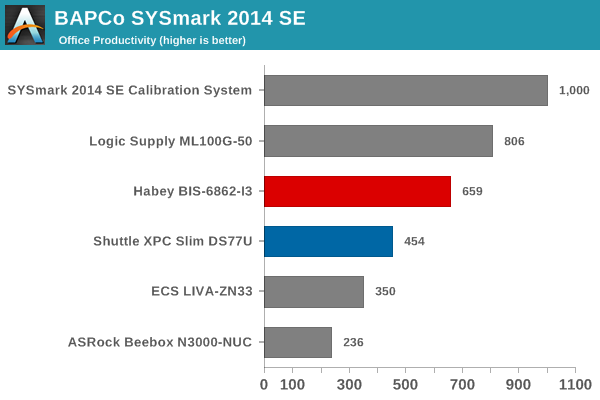
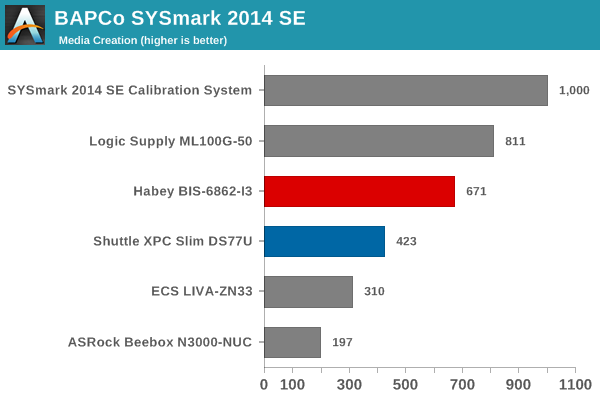
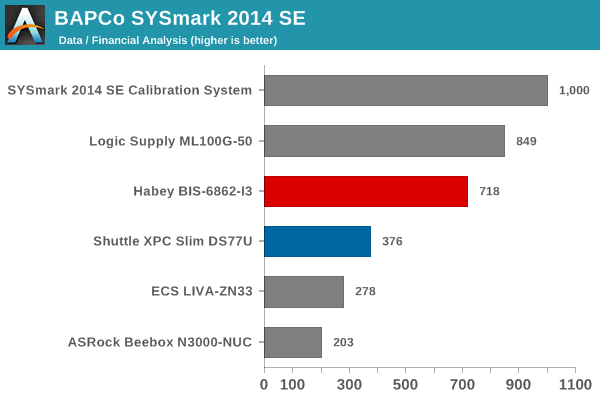
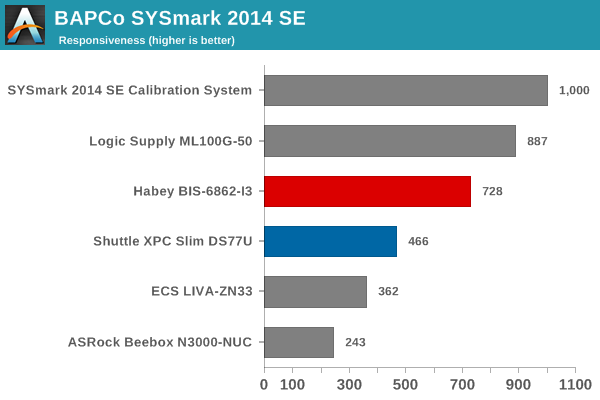
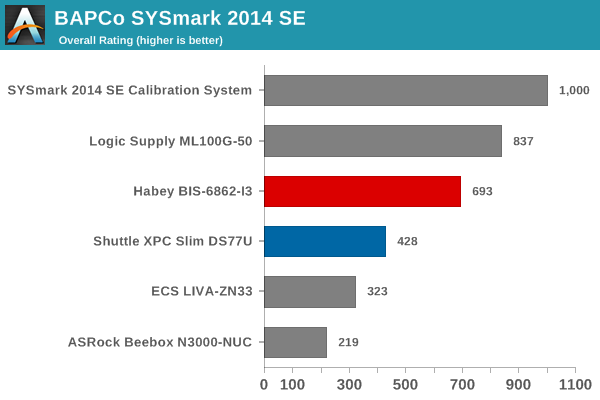
SYSmark 2014 SE also adds energy measurement to the mix. A high score in the SYSmark benchmarks might be nice to have, but, potential customers also need to determine the balance between power consumption and the efficiency of the system. For example, in the average office scenario, it might not be worth purchasing a noisy and power-hungry PC just because it ends up with a 2000 score in the SYSmark 2014 SE benchmarks. In order to provide a balanced perspective, SYSmark 2014 SE also allows vendors and decision makers to track the energy consumption during each workload. In the graphs below, we find the total energy consumed by the PC under test for a single iteration of each SYSmark 2014 SE workload and how it compares against the calibration systems.
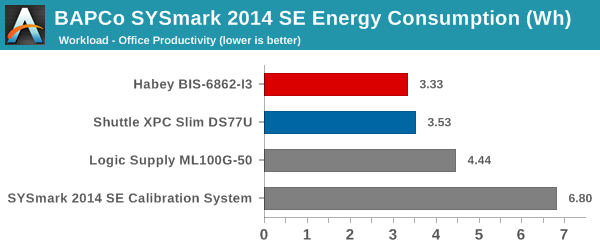
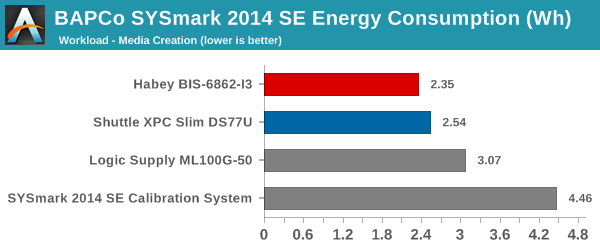
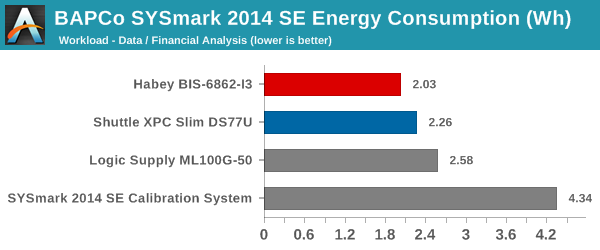
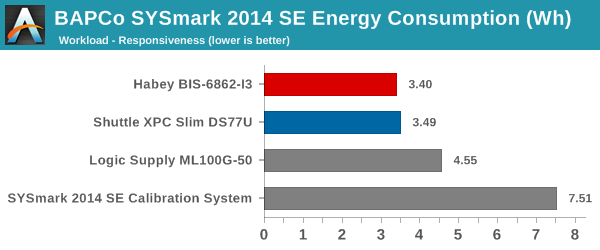
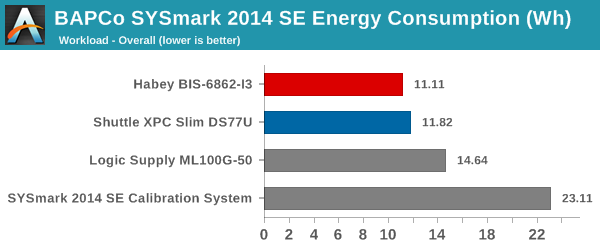
The Core i3-equipped Habey BIS-6862-I3, with its hyperthreading feature (2C/4T), scores better than the dual-core Celeron equipped Shuttle DS77U, as expected. The DS77U is better than the Atom-class fanless PCs (despite being much closer in cost to them). The surprising segment of the results is the fact that the Habey unit is more energy-efficient compared to the Shuttle PC for all the evaluated SYSmark 2014 SE workloads. The Skylake-based Logic Supply ML100G-50 leads the performance charts above, but, is not as energy efficient as the Kaby Lake systems. One of the important caveats here is that SYSmark 2014 SE consistently errored out when the benchmark was run on the DS77U with its original single SODIMM 4GB configuration. The scores presented above for the DS77U are with a 1x 16GB DDR4-2133 SODIMM (all other benchmark numbers for the DS77U in this article are with the 1x 4GB SODIMM put in place by Shuttle).
Futuremark PCMark 10
UL's PCMark 10 evaluates computing systems for various usage scenarios (generic / essential tasks such as web browsing and starting up applications, productivity tasks such as editing spreadsheets and documents, gaming, and digital content creation). We benchmarked select PCs with the PCMark 10 Extended profile and recorded the scores for various scenarios. These scores are heavily influenced by the CPU and GPU in the system, though the RAM and storage device also play a part. The power plan was set to Balanced for all the PCs while processing the PCMark 10 benchmark.
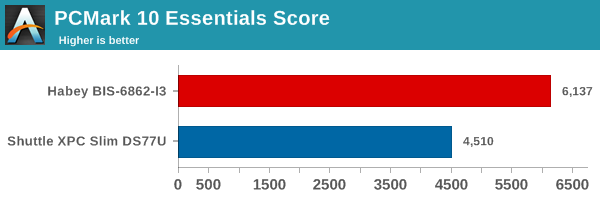
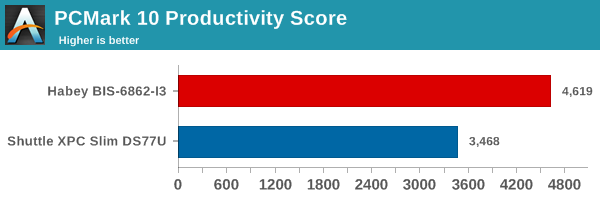
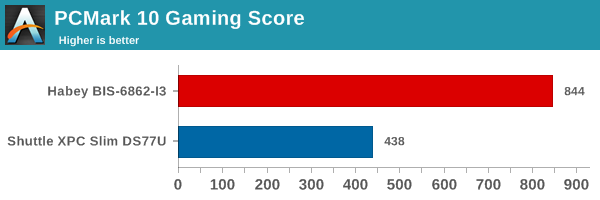
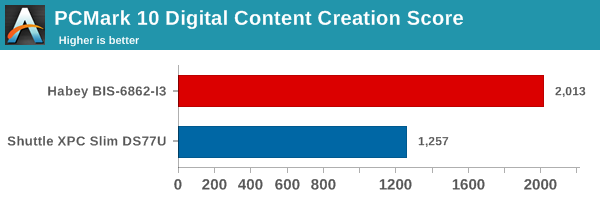
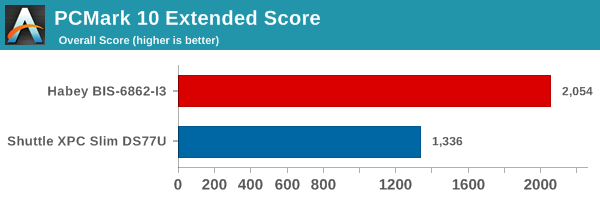
Futuremark PCMark 8
We continue to present PCMark 8 benchmark results (as those have more comparison points) while our PCMark 10 scores database for systems grows in size. PCMark 8 provides various usage scenarios (home, creative and work) and offers ways to benchmark both baseline (CPU-only) as well as OpenCL accelerated (CPU + GPU) performance. We benchmarked select PCs for the OpenCL accelerated performance in all three usage scenarios. These scores are heavily influenced by the CPU in the system. The Broadwell and Skylake-based Core i5 ML100G units from Logic Supply outperform the Habey and Shuttle systems, as expected. When graphics benchmarks enter the picture, the Intel HD Graphics 620 in the Habey unit manages to edge past the integrated GPU in the Broadwell-based Logic Supply ML100G-30.
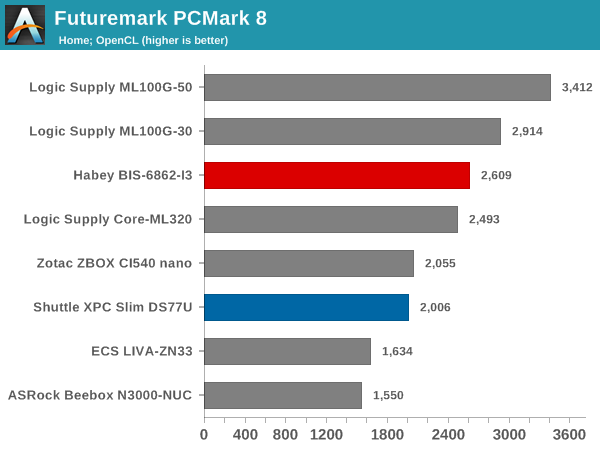
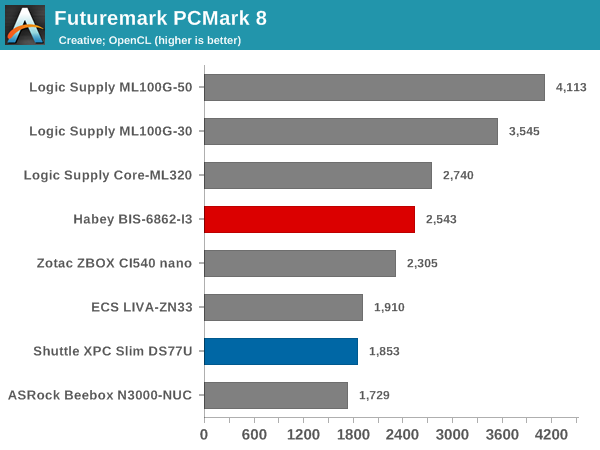
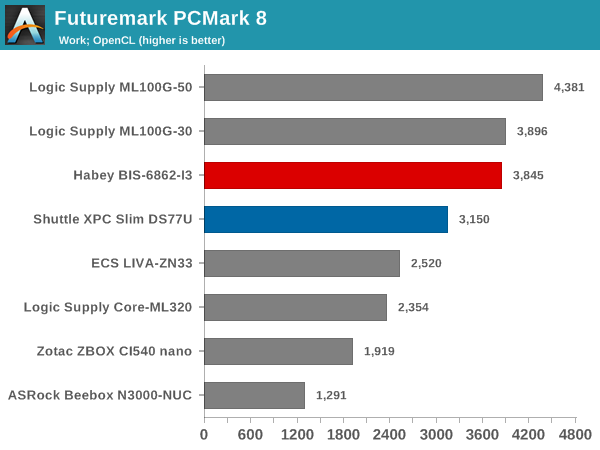
Miscellaneous Futuremark Benchmarks
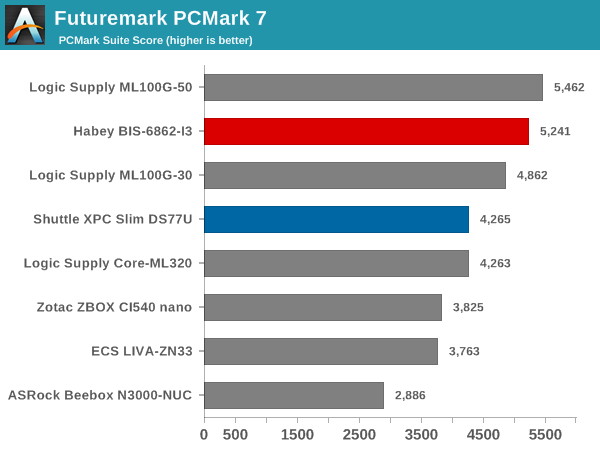
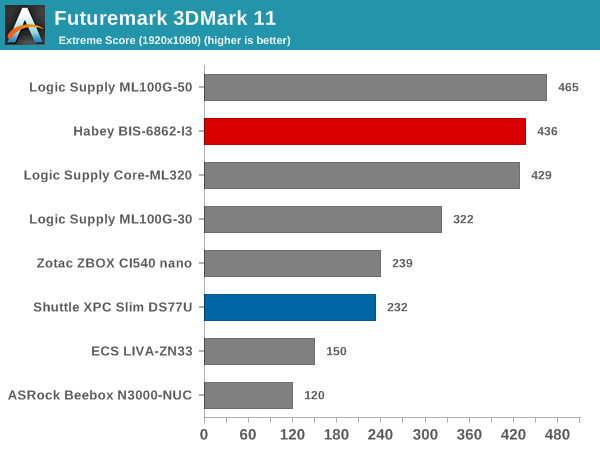
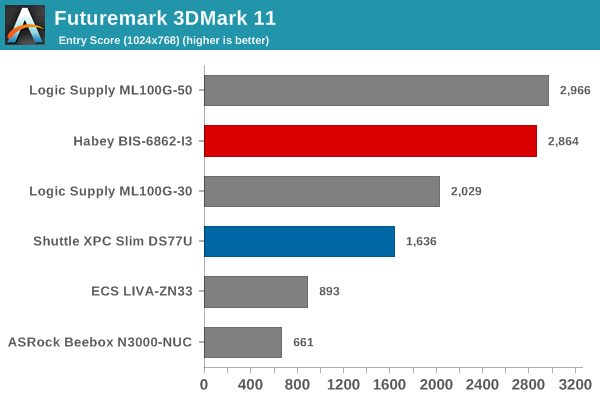
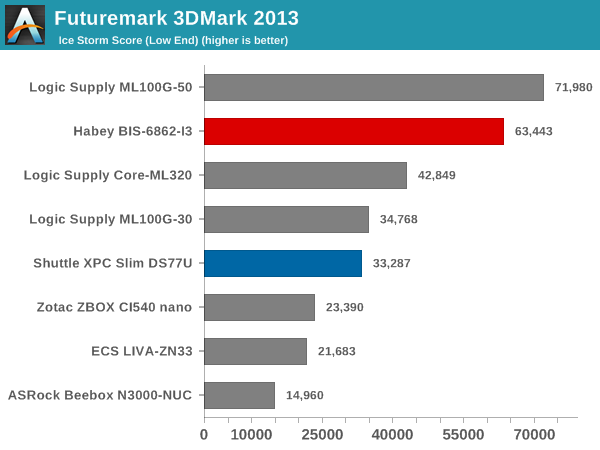
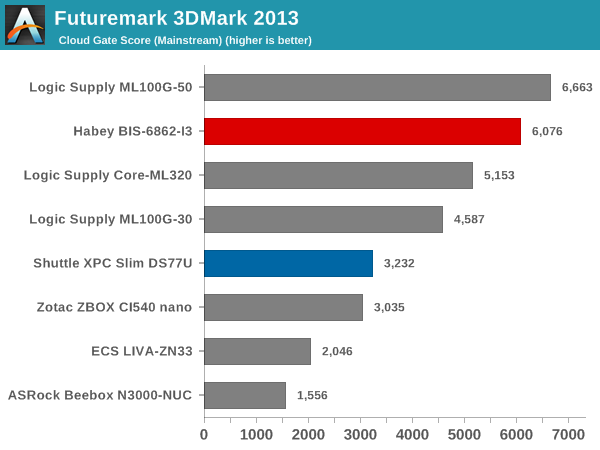
3D Rendering - CINEBENCH R15
We have moved on from R11.5 to R15 for 3D rendering evaluation. CINEBENCH R15 provides three benchmark modes - OpenGL, single threaded and multi-threaded. Evaluation of select PCs in all three modes provided us the following results. The OpenGL results for the Habey unit are very encouraging, though the pure CPU-based numbers are still not as good as those obtained with the Broadwell and Skylake Core i5-based units.
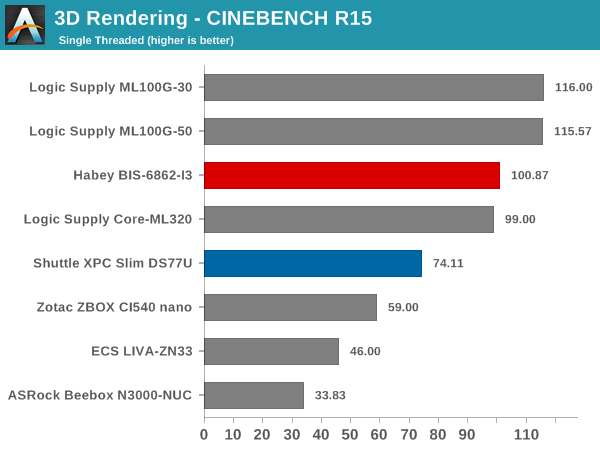
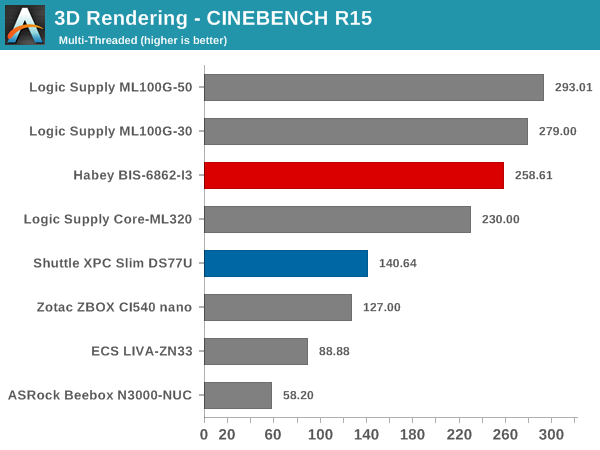
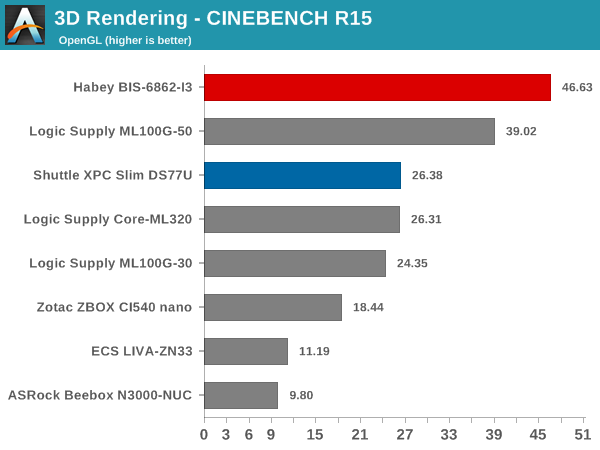
Performance Metrics - II
In this section, we mainly look at benchmark modes in programs used on a day-to-day basis, i.e, application performance and not synthetic workloads.
x264 Benchmark
First off, we have some video encoding benchmarks courtesy of x264 HD Benchmark v5.0. This is simply a test of CPU performance. As expected, the Habey unit comes behind the Core i5-based Logic Supply units. The Shuttle unit is the better than the Atom-class systems, but, not as good as the other Core-based ones. Recent releases of the x264 benchmark can show even more impressive gains, as they make use of the latest and greatest features of the modern Intel processors.
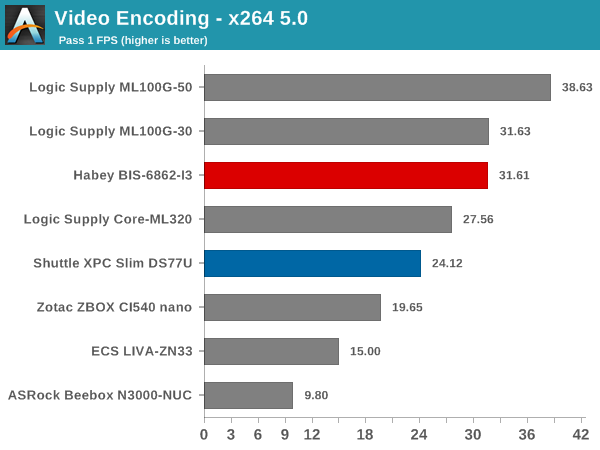
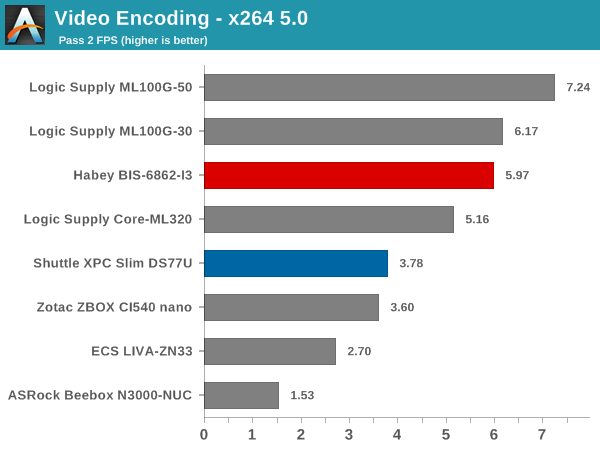
7-Zip
7-Zip is a very effective and efficient compression program, often beating out OpenCL accelerated commercial programs in benchmarks even while using just the CPU power. 7-Zip has a benchmarking program that provides tons of details regarding the underlying CPU's efficiency. In this subsection, we are interested in the compression and decompression MIPS ratings when utilizing all the available threads.
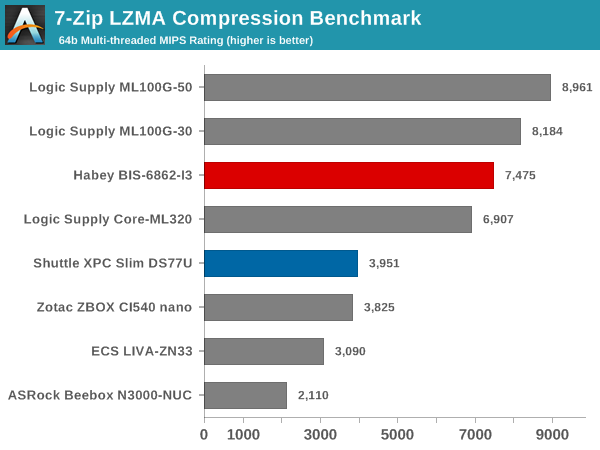
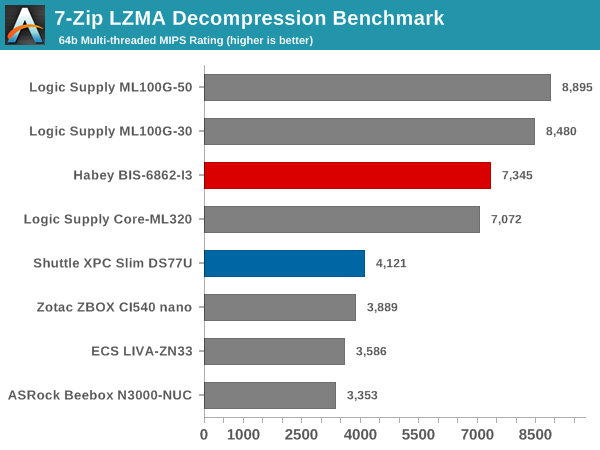
TrueCrypt
As businesses (and even home consumers) become more security conscious, the importance of encryption can't be overstated. CPUs supporting the AES-NI instruction for accelerating the encryption and decryption processes have become more widespread over the last few years. TrueCrypt, a popular open-source disk encryption program can take advantage of the AES-NI capabilities. The TrueCrypt internal benchmark provides some interesting cryptography-related numbers to ponder. In the graph below, we can get an idea of how fast a TrueCrypt volume would behave in the Habey BIS-6862-I3 and the Shuttle XPC Slim DS77U, with a comparison against other select PCs. This is a purely CPU feature / clock speed based test.
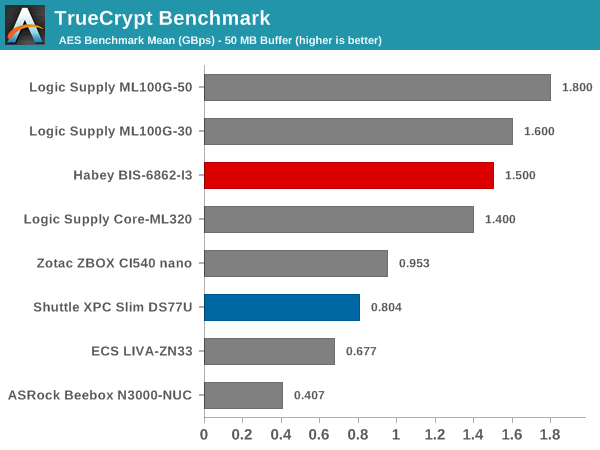
Agisoft Photoscan
Agisoft PhotoScan is a commercial program that converts 2D images into 3D point maps, meshes and textures. The program designers sent us a command line version in order to evaluate the efficiency of various systems that go under our review scanner. The command line version has two benchmark modes, one using the CPU and the other using both the CPU and GPU (via OpenCL). We have been using an old version of the program with 50 photogaphs in our reviews till now. The updated benchmark (v1.3) now takes around 84 photographs and does four stages of computation:
- Stage 1: Align Photographs (capable of OpenCL acceleration)
- Stage 2: Build Point Cloud (capable of OpenCL acceleration)
- Stage 3: Build Mesh
- Stage 4: Build Textures
We record the time taken for each stage. Since various elements of the software are single threaded, others multithreaded, and some use GPUs, it is interesting to record the effects of CPU generations, speeds, number of cores, DRAM parameters and the GPU using this software.
Stage 1 shows great benefits from GPU with systems having discrete GPUs. However, enabling them with the integrated GPU in the Intel processors seems to be detrimental compared to a pure CPU-based run. On the other hand, Stage 2 shows GPU acceleration delivring better results as expected.
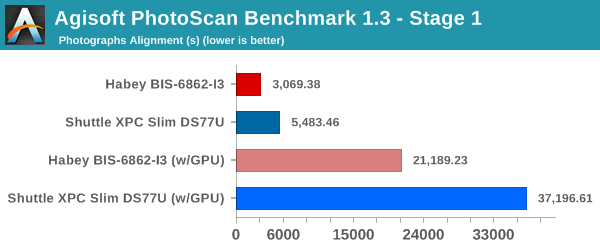
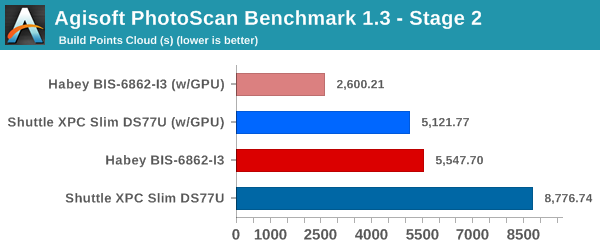
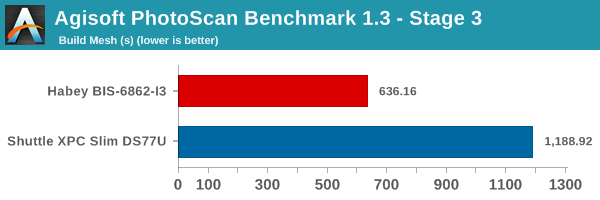
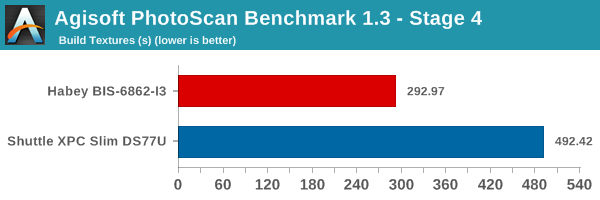
Dolphin Emulator
Wrapping up our application benchmark numbers is the new Dolphin Emulator (v5) benchmark mode results. This is again a test of the CPU capabilities, and the Habey system takes lesser time to complete the benchmark compared to the Shuttle unit.
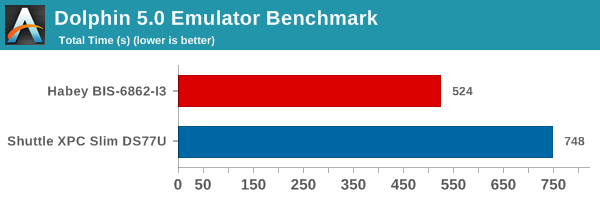
Networking and Storage Performance
Networking and storage are two major aspects which influence our experience with any computing system. This section presents results from our evaluation of these aspects in the Habey BIS-6862-I3 and the Shuttle PC Slim DS77U. On the storage side, one option would be repetition of our strenuous SSD review tests on the drive(s) in the PC. Fortunately, to avoid that overkill, PCMark 8 has a storage bench where certain common workloads such as loading games and document processing are replayed on the target drive. Results are presented in two forms, one being a benchmark number and the other, a bandwidth figure. We ran the PCMark 8 storage bench on selected PCs and the results are presented below.
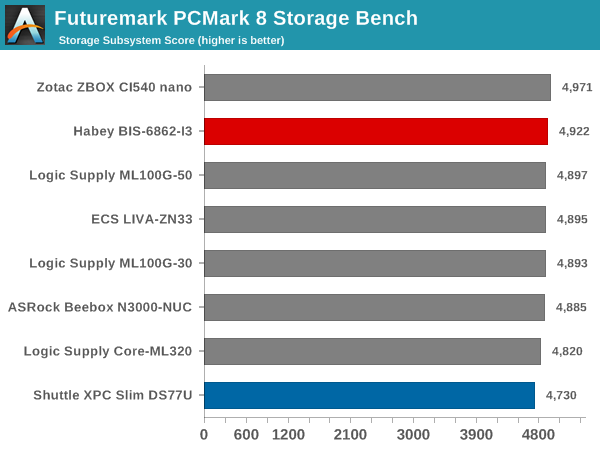
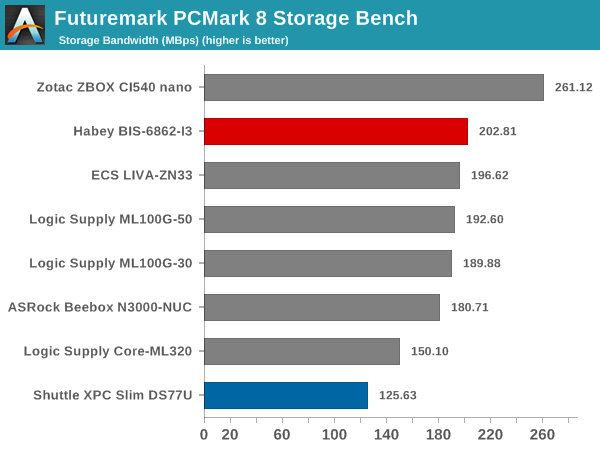
The WD Green in the Shuttle build is a budget option, and is not going to set any benchmark records, as can be seen above. However, for non-disk intensive workloads, the SSD is a good enough option compared to a HDD.
On the networking side, we restricted ourselves to the evaluation of the WLAN component. Our standard test router is the Netgear R7000 Nighthawk configured with both 2.4 GHz and 5 GHz networks. The router is placed approximately 20 ft. away, separated by a couple of drywalls (as in a typical US building). A wired client is connected to the R7000 and serves as one endpoint for iperf evaluation. The PC under test is made to connect to either the 5 GHz (preferred) or 2.4 GHz SSID and iperf tests are conducted for both TCP and UDP transfers. It is ensured that the PC under test is the only wireless client for the Netgear R7000. We evaluate total throughput for up to 32 simultaneous TCP connections using iperf and present the highest number in the graph below.
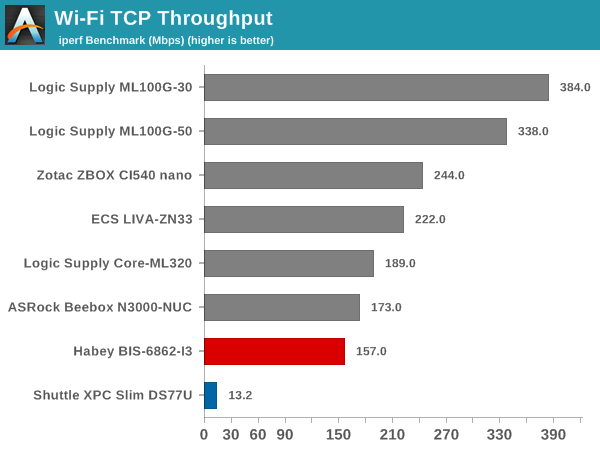
In the UDP case, we try to transfer data at the highest rate possible for which we get less than 1% packet loss.
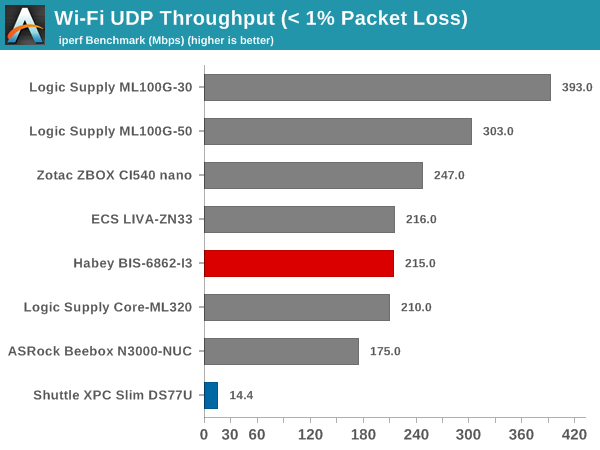
The Shuttle system with its 802.11n 1x1 WLAN card and no external antenna looks quite bad compared to the numbers from all the 802.11ac cards in the other systems. The leading ones in the chart use 2x2 cards, but, the Habey build is equipped with a 1x1 configuration. Users with a need for better WLAN performance can always install their own WLAN modules.
4K HTPC & Digital Signage Credentials
The Habey BIS-6862-I3 and the Shuttle XPC Slim DS77U are both passively cooled machines and have a zero noise profile (thanks to the absence of any moving part). This makes them ideal home theater PCs, but, the absence of a HDMI 2.0 port and HDCP 2.2 support are downers for contemporary setups. That said, it is not a major issue for digital signage purposes. Our evaluation used the Display Port 1.2 port of the PCs connected to a TCL55P607 through the Denon AVR X3400H. An active Plugable DP 1.2 to HDMI 2.0 adapter was needed to complete the chain.The desktop resolution was set to 3840x2160 @ 59.94 Hz. It must be noted that the Shuttle system does not transport audio over the Display Port output, while the Habey system can.
Refresh Rate Accuracy
Starting with Haswell, Intel, AMD and NVIDIA have been on par with respect to display refresh rate accuracy. As expected, the Habey BIS-6862-I3 and the Shuttle XPC Slim DS77U have no trouble with matching the display refresh rate to the source frame rate. This is important for both videophiles and digital signage applications.
The galleries in this subsection presents the tested refresh rates for both PCs. The first statistic in madVR's OSD indicates the display refresh rate.
Network Streaming Efficiency
Evaluation of OTT playback efficiency was done by playing back the Mystery Box's Peru 8K HDR 60FPS video in YouTube using Microsoft Edge and Season 4 Episode 4 of the Netflix Test Pattern title using the Windows Store App.
YouTube Streaming with the Habey BIS-6862-I3 using Microsoft Edge
On the Habey BIS-6862-I3, the YouTube streaming test played back the 4K non-HDR version (VP9 video and Opus audio), while the Netflix one delivered the 6.96 Mbps 1080p HEVC version with multi-channel audio.
Netflix Streaming with the Habey BIS-6862-I3 using the Windows Store App
The graph below shows the power consumption at the wall and the GPU loading parameters for the YouTube streaming case. Initially, the power consumption is a bit high as the video is fetched at a lower resolution (less VPU load), but, needs to be scaled up for display. The power consumption (around 12.5W) and the media engine load (around 55%) stabilize after the buffering reaches a steady state and the maximum resolution starts playing back.
A similar graph for the Netflix streaming case is also presented below. Manual stream selection is available (Ctrl-Alt-Shift-S) and debug information / statistics can also be viewed (Ctrl-Alt-Shift-D). Statistics collected for the YouTube streaming experiment were also collected here.
It must be noted that the debug OSD is kept on till the stream reaches the 6.96 Mbps playback stage around 100 seconds after the start of the streaming. In the steady state, we find that the media engine load is around 60%, while the GPU load is around 3%. The power consumption is around 12.5W.
On the Shuttle XPC Slim DS77U, the YouTube streaming test surprisingly played back the 4K HDR version (VP9 Profile 2 video and Opus audio) despite the OS not allowing HDR to be activated at all.
YouTube Streaming with the Shuttle XPC Slim DS77U
The Netflix Store app delivered the 5.8 Mbps 1080p AVC version of the test title.
Netflix Streaming with the Shuttle XPC Slim DS77U
The graph below shows the power consumption at the wall and the GPU loading parameters for the YouTube streaming case. The playback really suffers with a large number of dropped frames due to the saturated GPU load. It is not clear why the Edge browser fetches an unfriendly stream for the YouTube test title. The wall power is close to 17W and the media engine load is between 50 and 60% showing that there is some amount of hardware assistance for the decoding.
A similar graph for the Netflix streaming case is also presented below. Manual stream selection is available (Ctrl-Alt-Shift-S) and debug information / statistics can also be viewed (Ctrl-Alt-Shift-D). Statistics collected for the YouTube streaming experiment were also collected here.
It must be noted that the debug OSD is kept on till the stream reaches the 5.8 Mbps playback stage around 2 minutes after the start of the streaming. In the steady state, we find that the media engine load is around 10%. The power consumption is around 9W.
Decoding and Rendering Benchmarks
In order to evaluate local file playback, we concentrate on Kodi and MPC-HC with EVR for the two systems. The integrated GPUs are too weak to handle madVR. We recently revamped our decode and rendering test suite, as described in our 2017 HTPC components guide. For the purpose of testing, we utilized Kodi 17.6, MPC-HC x64 1.7.13, and LAV Filters 0.70.1-83. The video decoder was set to native DXVA2 mode.
The testing with the Habey BIS-6862-I3 shows that there is no hardware decode for VP9 Profile 2 videos when using Kodi, but, it is activated with the LAV Video Decoder in DXVA2 Native mode. However, the GPU load in the latter case is too high to prevent dropped frames for that test stream.
On to the Shuttle XPC Slim DS77U, we only tested Kodi.
Disappointingly, the Intel HD Graphics 610 is too weak to handle 4Kp60 HEVC videos, as shown by the saturated media engine load in the aboe graph. That said, the results also show that the Shuttle system has no troubles with 1080p streams.
Power Consumption and Thermal Performance
The power consumption at the wall was measured with the LG43UD79-B monitor driven at 3840x2160 / 59.94 Hz using the Display Port output of the systems. In the graphs below, we compare the idle and load power of the Habey BIS-6862-I3 and the Shuttle XPC Slim DS77U with other low power PCs evaluated before. For load power consumption, we ran the AIDA64 System Stability Test with various stress components, as well as our custom stress test, and noted the maximum sustained power consumption at the wall.
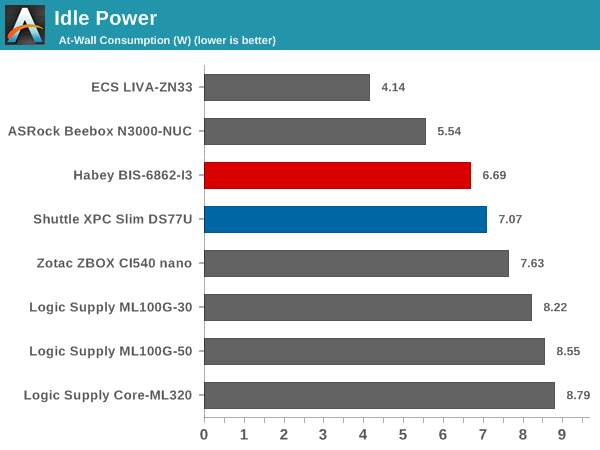
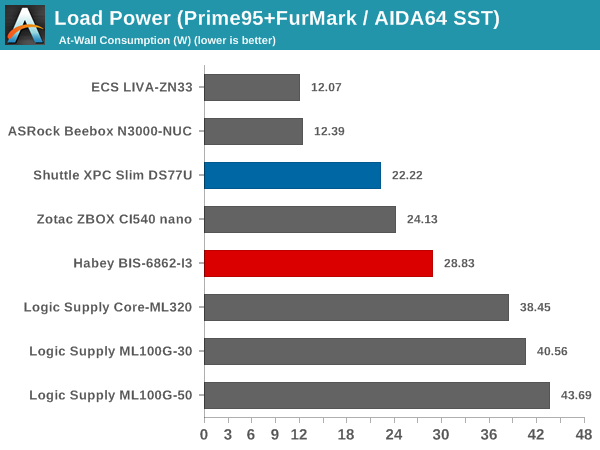
The Habey system has surprisingly lower idle power compared to the Shuttle unit, though it is not as low as the Atom-based fanless systems we have evaluated before. The load power graph is along expected lines - the Shuttle system is closer to the Atom-class units, while the Habey one is closer to the other Core-equipped fanless PCs.
Our thermal stress routine starts with the system at idle, followed by four stages of different system loading profiles using the AIDA64 System Stability Test (each of 30 minutes duration). In the first stage, we stress the CPU, caches and RAM. In the second stage, we add the GPU to the above list. In the third stage, we stress the GPU standalone. In the final stage, we stress all the system components (including the disks). Beyond this, we leave the unit idle in order to determine how quickly the various temperatures in the system can come back to normal idling range. The various clocks, temperatures and power consumption numbers for the system during the above routine are presented in the graphs below.
| Habey BIS-6862-I3 AIDA64 System Stability Test | |||
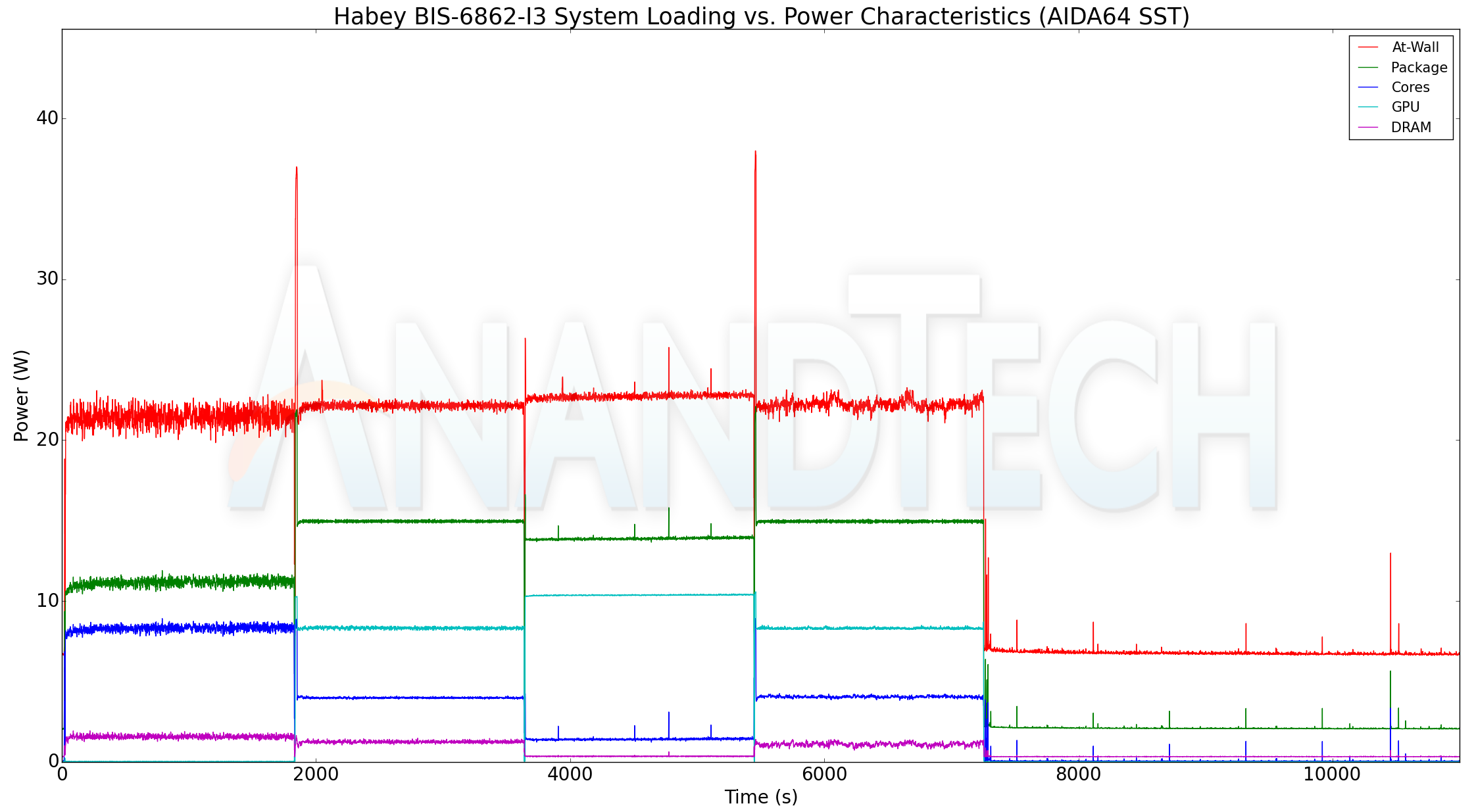
The AIDA64 SST shows consistent power consumption under load from the Habey system. We see that the package power is close to the claimed 15W for two of the four workload segments. There is no throttling at play here. On the other hand, we see that the Shuttle unit seems to be running at 7.5W maximum package power (which could have something to do with the use of a single SODIMM and leaving one of the DRAM slots empty). Temperature-wise, AIDA64 SST shows the package peaking at around 90C for the Habey unit, and 55C for the Shuttle unit. This shows that the Shuttle system is configured very conservatively in the default BIOS settings.
| Shuttle XPC Slim DS77U AIDA64 System Stability Test | |||
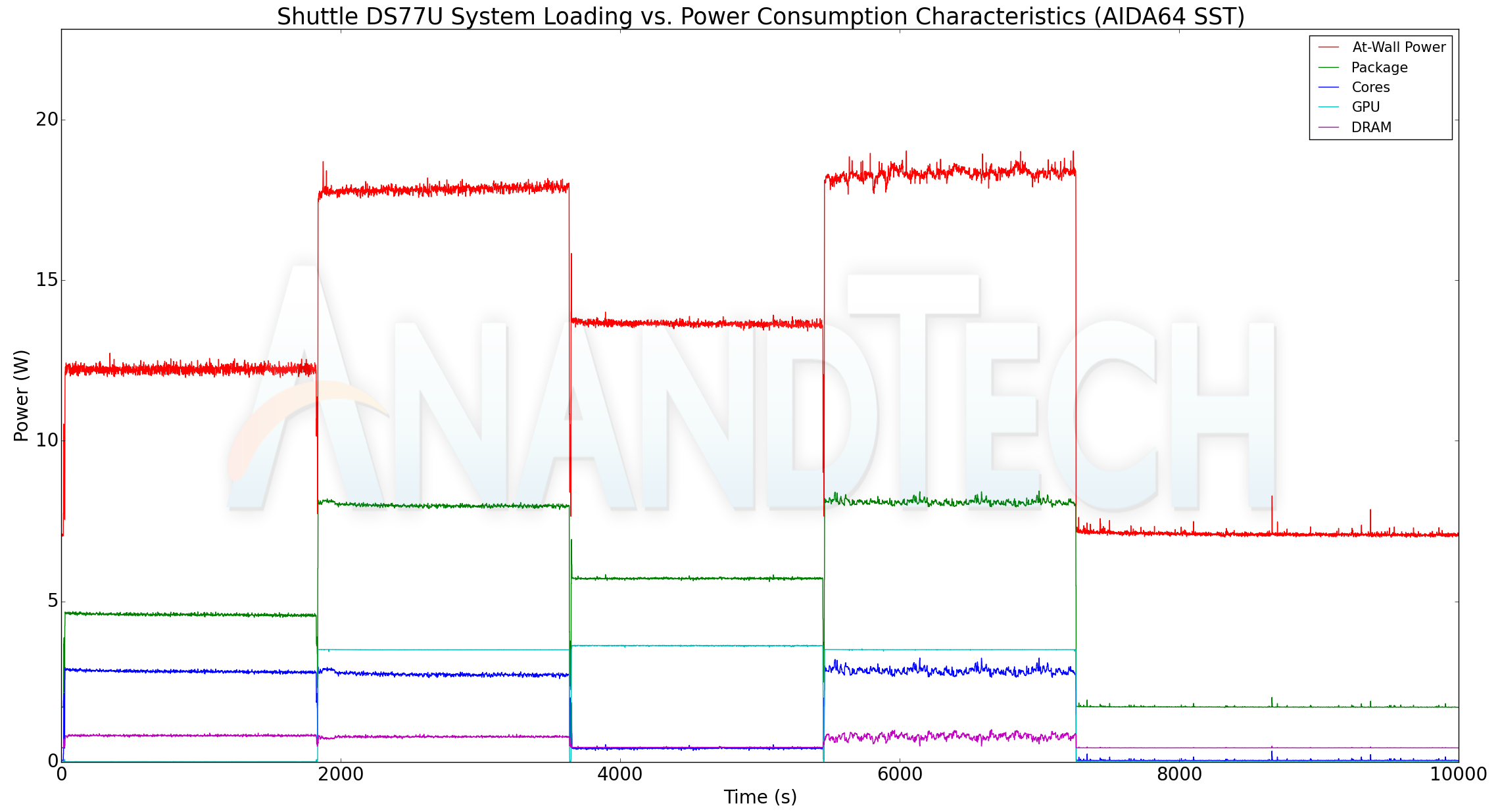
The AIDA64 system stability test uses real-world workloads to stress the system components. However, power virus tests such as the Prime 95 torture test and Furmark stability test can subject the system to greater stress. We repeated our thermal stress routine with 30 minutes of Prime 95 (v29.1), followed by 30 minutes of Prime 95 and Furmark (1.19.1). The Prime 95 load was then removed, and the GPU stressing Furmark test was allowed too run for another 30 minutes. The various clocks, temperatures and power consumption numbers for the system during the above routine are presented in the graphs below.
| Habey BIS-6862-I3 Custom Stress Test | |||
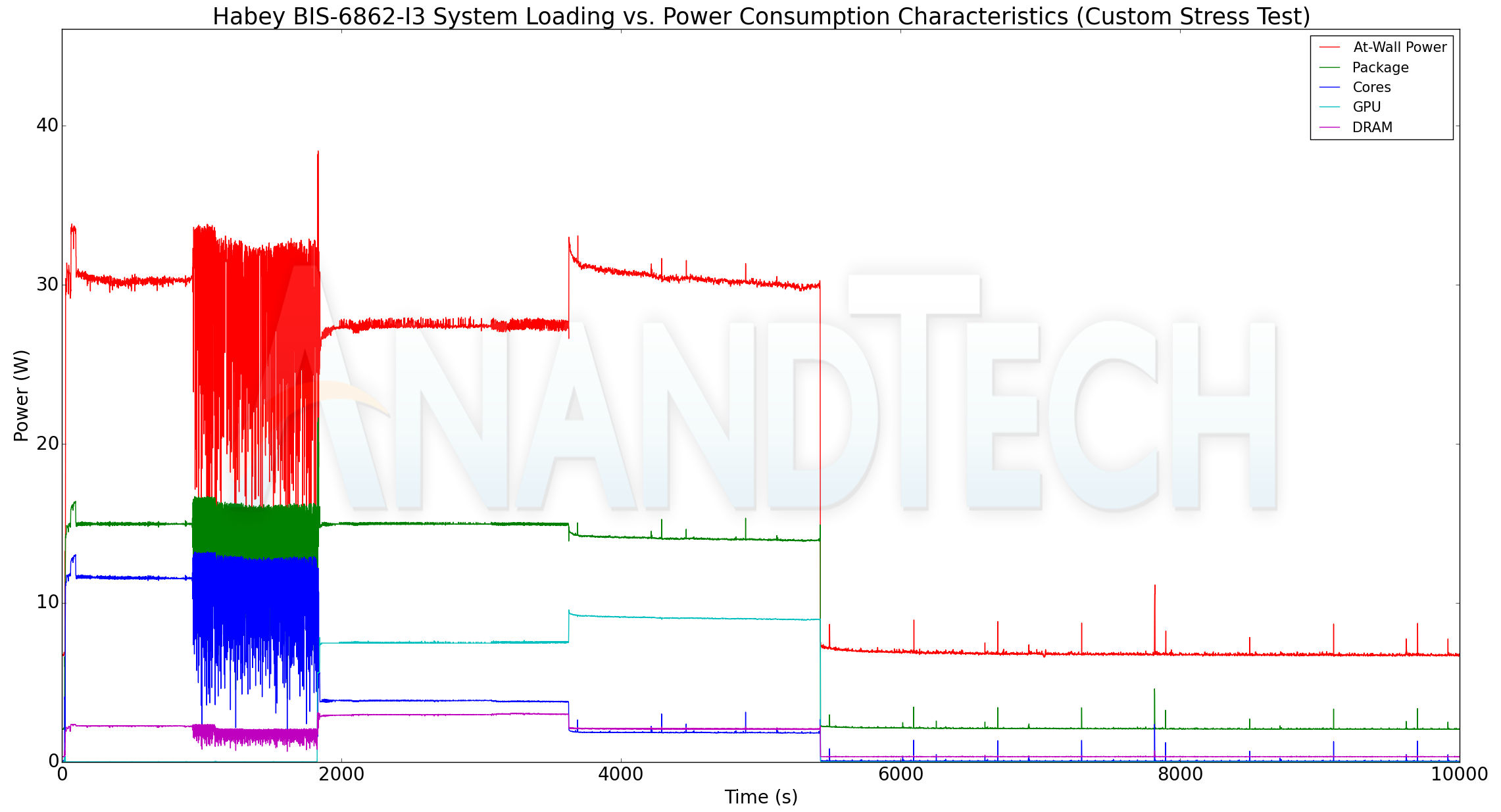
The Prime95 power virus test shows the protection mechanism kicking into action in the Habey system. After 15 minutes of continuous load, we see the power consumption at the wall going from around 30W to start oscillating between 18W and 32W. Correspondingly, the package power oscillates around the 15W mark. The protection against the power virus workload starts kicking in as soon as the package temperature reaches the 80C mark. Interestingly, running the GPU at full throttle actually rises the temperature to 98 - 99C. However, the GPU shifts in a narrow frequency range between 800 MHz and 1.05 GHz to ensure that the junction temperature is not reached.
| Shuttle XPC Slim DS77U Custom Stress Test | |||
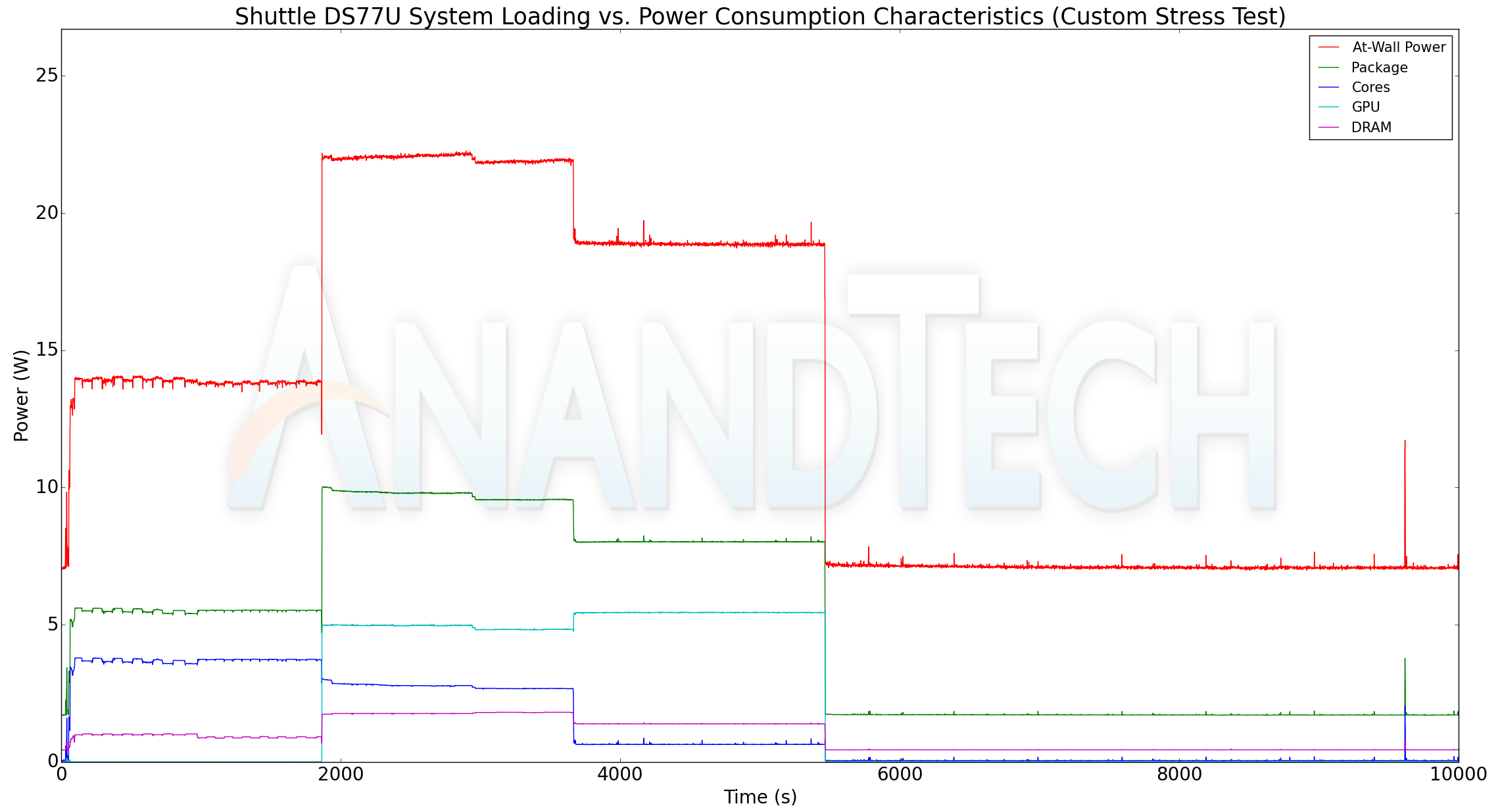
The Shuttle XPC Slim DS77U, on the other hand, shows that the package is actually configured for a maximum power of 10W. Thanks to the large number of ventilation holes and orientation requirements, the temperature of the package does not exceed 60C even under heavy loading.
Miscellaneous Aspects & Concluding Remarks
An important aspect to keep note of while evaluating fanless PCs is the chassis temperature. Using the Android version of the FLIR One Pro thermal imager, we observed the chassis temperature after the CPU package temperature reached the steady state value in our stress testing.
We have additional thermal images in the gallery below.
The chassis temperatures of around 50C - 60C are quite reasonable given the internal numbers.
Coming to the business end of the review, we find that the two industrial PCs have performance commensurate with the street pricing. In the industrial PC space, feature requirements often trump the budget. Interestingly, the two KBL-U systems have some unique aspects. The Habey BIS-6862-I3 comes with a SIM slot, while the Shuttle XPC Slim DS77U doesn't. On the other hand, the DS77U can support three simultaneous displays, while the BIS-6862-I3 can support only two. Both carry a large number of USB 2.0 ports, serial COM ports, and dual gigabit LAN interfaces. Consumers can choose either system based on their requirements.
There is definite scope for improvement in both systems, though. The AMI BIOS in both of them is quite basic, and doesn't expose ways to, say, control the power limits, or enable SGX. In our testing, the Shuttle system's CPU package could go up to only 10W, while the Habey system allowed the Core i3-7100U to dissipate 15W over an extended period of time. However, Habey's cooling solution could improve a little bit to transfer heat away from the package faster.
In terms of pricing, we have the Habey BIS-6862-I3 at $325, while the Shuttle XPC Slim DS77U is available for $223. These are par for the course when it comes to fanless industrial PCs. In a market segment where Atom-based systems form the majority of the offerings, such systems with relatively high performance are welcome offerings.

